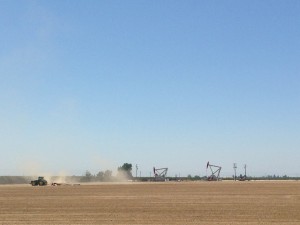
By Andrew Grinberg, Oil and Gas Program Coordinator
Update: Read Senator Pavley's letter to the Senate Journal here.
The California Legislature has finally spoken on fracking. After almost 3 years of intense public pressure to address the risky oil and gas extraction process, SB 4 (Pavley) will put in place the first ever rules in California for fracking and acidizing. While the bill will put in place numerous important safeguards, last minute, industry-friendly amendments were forced into the bill and threaten to undermine the intent of the law: to take the first step in protecting California from fracking.
Clean Water Action worked to support and strengthen SB 4 through the first 9 months of the legislative session, helping to create a solid piece of legislation with broad support and numerous safeguards against fracking and acidizing. Unfortunately, we withdrew our support when, as we feared might happen, amendments were added that threaten to undercut our most important environmental law, the California Environmental Quality Act (CEQA).
Like any major piece of legislation there is good and bad in SB 4. Let’s take stock.
Here’s what we won:
The referenced media source is missing and needs to be re-embedded.
Let's Fix the Fracking Bill- For the first time ever, California will regulate fracking and other risky well stimulation processes like acidizing.
- A new groundwater monitoring program will help identify problems and hold industry accountable for their pollution.
- Requiring a permit for fracking and acidizing, as opposed to the status quo of anything goes and limited oversight.
- Public disclosure of every single chemical injected into a well even if a trade secret is claimed. California will now have the strongest fracking disclosure law in the country.
- Direct notification to neighbors prior to any fracking or acidizing.
- An independent study to examine all the risks of well stimulation.
- The potential for our state regulatory agency, the Division of Oil Gas and Geothermal Resources (DOGGR) to limit environmental review and mitigation under CEQA.
- An interim period of one year, while the regulations are being developed, in which DOGGR may have limited authority to stop well stimulation projects.
- Pressure the Governor for a moratorium. Jerry Brown has the existing authority to halt fracking and acidizing today. Take action today to make him do it! Despite reports that the bill prevents the Governor from imposing a moratorium, we disagree with this analysis and call on him to act immediately.
- Fix the bill. We have called on the Legislature and the Governor to fix the problematic amendments. It is absolutely necessary that the offending language in the bill be overturned as soon as possible.
- Work at the local level. Communities are mobilizing to stop fracking or enact strict regulations in their backyards. This is where the real fight is.
Related Posts
Stay Informed
Get the latest updates and actions:
Thanks for signing up!
There was a problem processing your signup. Please try again.


